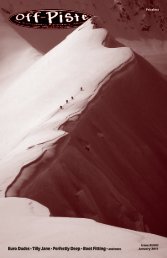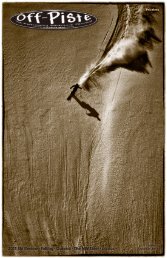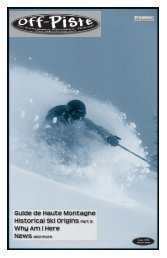Ski Review 03-04 The Fall Line Blisters 100 ... - Off-Piste Magazine
Ski Review 03-04 The Fall Line Blisters 100 ... - Off-Piste Magazine
Ski Review 03-04 The Fall Line Blisters 100 ... - Off-Piste Magazine
You also want an ePaper? Increase the reach of your titles
YUMPU automatically turns print PDFs into web optimized ePapers that Google loves.
<strong>The</strong> End of an Era<br />
A Retrospective Look at Tua <strong>Ski</strong>s<br />
by Ray Thomas<br />
<strong>The</strong> 1987 Great Pacific Catalog, the first time Tua skis were offered in the US.<br />
For many backcountry skiers August 7th marked the end of an<br />
era. On that day Gestione Sport Alpini s.r.l., the parent<br />
company of Tua skis, announced that it had filed papers for the<br />
Italian version of Chapter 11. Tua has had a long and intimate<br />
relationship with the backcountry skiing world. Tua’s ski history dates back<br />
to just after World War II when Nanni Tua’s father converted the family<br />
machine shop business into a ski factory. Nanni’s father died quite young<br />
and as a result Nanni took over the factory at an early age. <strong>The</strong>y sold Alpine<br />
skis but it was tough to compete with the big guys, so they became better<br />
known as a specialty ski manufacturer focused on Alpine Touring and more<br />
recently telemark skis. Tua was well known in Europe in the mid-80s for AT<br />
skis, specifically the Excalibur. It was right around that time that Chouinard<br />
Equipment brought them into the United States.<br />
In North America, Tua skis helped to fuel the rebirth of telemark skiing. For<br />
many long-time freeheelers, the name Tua is synonymous with the<br />
backcountry and sweet flex. While the brand had some difficult times over<br />
the years, they were coming back strong and had experienced several<br />
seasons of successful models and had designed some big hits for the<br />
20<strong>03</strong>/4 season. Thus the news of bankruptcy was a shock to most of the ski<br />
community. Tua may yet reorganize and provide their brand of skis to the<br />
backcountry market, the future is uncertain. While we wait to know what<br />
happens next, lets look back and remember the fine rides that Tua <strong>Ski</strong> has<br />
brought us.<br />
Tua skis first appeared in the third Great Pacific Catalog, winter’87. Great<br />
Pacific was a retail mail-order enterprise, a division of Chouinard Equipment,<br />
which focused solely on the<br />
backcountry skiing market; it was<br />
the first of its kind. Paul Parker, who<br />
would later go on to write one of<br />
the definitive telemark books<br />
‘Freeheel <strong>Ski</strong>ing’ and help design<br />
Tua skis, was at the time a<br />
Chouinard Equipment employee<br />
who spearheaded the GPC<br />
enterprise. He personally selected<br />
and tested all the gear that would<br />
be available in the catalog and<br />
wrote the copy as well. Parker was<br />
also instrumental in getting those<br />
first Tuas into the catalog and right<br />
from the start they were a hit. <strong>The</strong><br />
legendary Tout Neige (74/60/64)<br />
made its appearance as a very solid<br />
and stable ski that was confidence<br />
inspiring in difficult snow<br />
conditions. Tua also introduced<br />
<strong>The</strong> Expresso and Toute Neige circa 1987<br />
two skis that were some of the first<br />
‘fat and wide’, the Excalibur (90/70/79) and Excalibur Magnum. <strong>The</strong> alpine<br />
touring market in the US was very small and these skis were quite popular<br />
with this crowd as well as tele folks in places like the Sierras and Cascades.<br />
<strong>The</strong> backcountry and telemark ski community was in a formative stage in<br />
the late ‘80’s. Steve Hardesty, president of Cima Sports, the North American<br />
distributor of Tua <strong>Ski</strong>s for many years, explained it this way, “<strong>The</strong> tele market<br />
was pretty laid back. Mostly renegade backcountry tourers looking to dial it<br />
up a notch and a few disenchanted ex-alpine hotshots looking for a new<br />
scene. <strong>The</strong> gear was improving but still pretty primitive – a garage workshop<br />
was practically a prerequisite to participate in the sport.”<br />
Asolo’s Extreme Plus and later Scarpa’s Boot Sauvage and Boot Expresso<br />
defined the performance telemark boot. Bindings were mostly three-pin and<br />
basic cable. Tua skis were introduced into a market dominated by Rossignol<br />
and Karhu. From the very beginning Tua focused on quality construction<br />
and technological innovation. Every ski, from those first few in the Great<br />
Pacific catalog to last season’s skis, used solid wood cores. <strong>Ski</strong>ers will also<br />
remember Tua’s ‘Driving Effect’, the variable angle sidewall that helped the<br />
skis deliver their excellent deep snow performance.<br />
In the winter of ‘88 Tua again introduced a definitive telemark ski - the Tele<br />
Sauvage. It was a radically designed ski for its day with 20mm of side cut.<br />
With dimensions of 80/60/70 it was also as wide as some alpine slalom skis.<br />
Though some people in the backcountry ski community thought it was too<br />
much like an alpine ski, many skiers loved them and the Tele Sauvage<br />
became THE ski to have and remained that way for several seasons. Parker<br />
had this to say about the Tele Sauvage. “In developing subsequent skis, I<br />
always used it as my benchmark. It was hard to develop something that<br />
skied better.”<br />
Telemark ski design took another radical departure from the status quo<br />
when Tua introduced the Montet MX in 1993. It was the first monocoque<br />
telemark ski and a very wide ride for the day at 84/64/74. Over the next year<br />
Tua switched all their models over to monocoque construction. This gave<br />
them skis that were light and quick turning with great torsional rigidity. What<br />
helped bring about this new level of ski performance was another radical<br />
departure from the norm – Scarpa’s introduction of the all-plastic Terminator<br />
tele boot in the early ‘90s. This boot made it possible to control wider more<br />
side cut skis.<br />
With the advent of plastic boots and wider more easily turned skis, telemark<br />
skiing began a new renaissance. No longer was telemark skiing simply a<br />
backcountry pursuit, it became more common at the ski areas too.<br />
Telemarkers were no longer ‘hope turning’ their way down steep lines, but<br />
ripping it with the best of their fixed heel siblings. As freeheel skiing’s<br />
popularity rose, the larger alpine ski companies began to join the game. As<br />
a result, the smaller backcountry rooted companies lost market share.<br />
Manufactures like K2 and Atomic adapted their alpine ski molds to telemark<br />
needs and created skis at lower cost. Tua responded to this competition<br />
with new technologies and a series of increasingly wide and shaped ski still<br />
known for their sweet flex.<br />
<strong>The</strong> Original TeleSavage circa 1988<br />
<strong>The</strong> Big Easy (<strong>100</strong>/72/90) introduced in ’99 and the Sumo (110/76/<strong>100</strong>) of ’01<br />
were very successful for Tua. Both skis excelled in the backcountry and at<br />
the ski area. <strong>The</strong> Sumo was especially noteworthy as it pushed the concept<br />
of what a ‘wide’ tele ski looked like. Tua was also very aware that many of<br />
the new freeheel skiers who were pushing the boundaries of the sport came<br />
from alpine backgrounds and demanded alpine style performance from their<br />
skis. So in response, Tua introduced the Cross-Ride series of skis in 2001.<br />
<strong>The</strong> 110, 112 and 105 were stiff and stable at speed and appropriate for both<br />
fixed and free heel mountings. <strong>The</strong> Cross-Ride 110 (110/76/<strong>100</strong>) was an<br />
instant classic garnering top ski reviews and editor’s choice awards for<br />
several seasons. Tua didn’t forget about the backcountry purist either with<br />
the creation of the Cross-Light series. Started in ’00 with the Helium (<strong>100</strong>/72/<br />
90 and narrow for the day) the line soon expanded with wider offerings, the<br />
Hydrogen (1<strong>03</strong>/73/93) and the Nitrogen (107/75/<strong>100</strong>).<br />
What was the ‘<strong>03</strong>/’<strong>04</strong> season going to bring from Tua? <strong>The</strong> line would have<br />
seen the introduction of several new models and all new graphics. Three<br />
skis would have been especially important <strong>The</strong> Bubba(126/93/113) , <strong>The</strong><br />
Tsunami (121/83/1<strong>04</strong>), and the Titan. <strong>The</strong> Titan replaced the Cross-Ride 112,<br />
with the same dimensions but with Titanal construction. <strong>The</strong> Tsunami and<br />
Bubba would have been the widest skis ever produced by Tua as well as the<br />
first telemark skis with ‘Cross-Cap Construction’ (technology, found in<br />
some alpine skis that combines sandwich construction under foot with the<br />
torsional rigidity of monocoque at the tip and tail.<br />
Before the snow flies, we may yet know if Tua <strong>Ski</strong> will live again. Until then,<br />
hold onto those Tuas you might have. Enjoy the sweet flex and remember the<br />
role that Tua played in helping to shape the telemark world as we know it.<br />
Special Thanks goes to Paul Parker and Steve Hardesty for the help in making<br />
this article possible.<br />
Issue Issue XVIII XVIII <strong>Off</strong>-<strong>Piste</strong> 17









